Finding Family and Exploring Heritage: A Mother-Daughter Adventure in Poland
By TRAVELINK on October 19, 2015

August 2015
What started out as a dream vacation to appreciate our Polish heritage and attend a family wedding turned out to be a heady mix of architectural beauty, delectable food, medieval castles, and religious splendor. As an added bonus, this dream vacation was remarkably affordable.The vacation crowds we rubbed elbows with included extremely friendly Poles as well as tourists from Germany, the Nordic countries, Israel, and, of course, the United States. Tourists were spending with abandon given the favorable exchange rates for the Euro and the U.S. Dollar to the złoty (PLN). Restaurant tables were laden with appetizers, entrées, desserts, and liquor. Shops had lines of customers pulling out multinational credit cards. Young and handsome guides cheerfully shepherded knots of curious tourists along cobblestone streets, promenades, and wide boulevards, pointing right, left, and center at the magnificent churches, medieval architecture, lovingly restored pre-war homes, and enormous bronze public statuary. All the while, these energetic guides easily answered questions in three or four different languages. It was an amazing two weeks.
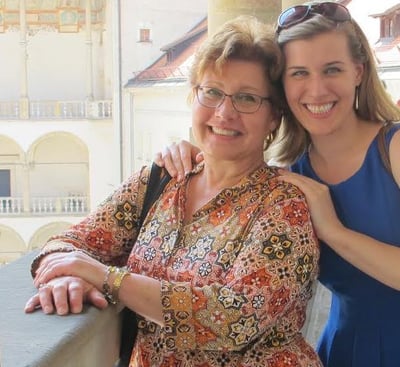 Late last year, our favorite cousin emailed us with the good news that in July 2015 she was coming to Poland from China for a hometown celebration of her marriage to a Chinese citizen, a wonderful man she met while living in the United Kingdom. My daughter Leslie and I began to consider the possibility of combining our dream vacation to tour Warsaw and Krakow with an additional trip to Pomerania (the Northwest region of Poland along the Baltic seacoast) to attend this celebration and reunite with relatives. A tentative celebration date was set for the third week in July, but the absolute date could not be set until complex Chinese visa and travel arrangements were finalized. This meant a group tour to Poland was out of the question. We needed to create a unique and flexible set of travel plans. It was our good fortune to choose Employee Vacation Programs, American Express Travel as our travel agency with their experienced advisors for our complicated vacation needs and itinerary.
Late last year, our favorite cousin emailed us with the good news that in July 2015 she was coming to Poland from China for a hometown celebration of her marriage to a Chinese citizen, a wonderful man she met while living in the United Kingdom. My daughter Leslie and I began to consider the possibility of combining our dream vacation to tour Warsaw and Krakow with an additional trip to Pomerania (the Northwest region of Poland along the Baltic seacoast) to attend this celebration and reunite with relatives. A tentative celebration date was set for the third week in July, but the absolute date could not be set until complex Chinese visa and travel arrangements were finalized. This meant a group tour to Poland was out of the question. We needed to create a unique and flexible set of travel plans. It was our good fortune to choose Employee Vacation Programs, American Express Travel as our travel agency with their experienced advisors for our complicated vacation needs and itinerary.
Since we wanted to purchase plane tickets for the height of the European vacation season at a reasonable price, Leslie and I decided to bracket the dates of the wedding related events with our plans for Warsaw and Krakow. In March of 2015, with Kerrie’s patience, advice, and assistance, we booked air travel and hotels, and planned for flexibility around the tentative celebration dates by arriving first in Gdansk, spending several days in the Pomeranian tri-city area (Gdansk, Sopot, Gdynia), then, after the wedding celebration, traveling to Warsaw and Krakow, returning to the U.S. from Krakow. This would allow us to adjust our schedule and hotels to accommodate any last minute changes in the wedding celebration dates.
Gdansk was not originally part of our dream itinerary, but, once there, we were delighted we came! Our decision to make Gdansk the first city on our trip made sense because the wedding events were three hours west of this magnificent seaport city. After an overnight flight from the U.S., we arrived at the top-notch Gdansk Hilton at 6:00 PM, the twilight hour. The Hilton is built on the intersection point of canals leading into the inner city from the harbor on the Baltic Sea. Just a few steps from the turret outside the Hilton’s entrance we found a canal-side cobbled promenade enveloped in a golden haze, stretching as far as the eye could see. This promenade was jammed with fabulous restaurants, shops, and tourists strolling in the breeze, enjoying the music floating over from the nightly performance at the nearby philharmonic hall. Pomerania is home to a Slavonic ethnic group called the Kashubians who colonized the tri-city area a thousand years ago.
This exuberant and politically active Polish subculture retains its unique German/Polish/Swedish dialect, traditions, and cuisine. To the delight of our taste buds, we were introduced to a ubiquitous side dish called Ogorki Kaszubskie, a highly seasoned “salad” of dill pickles, peppers, onions, and carrots spiked with horseradish.
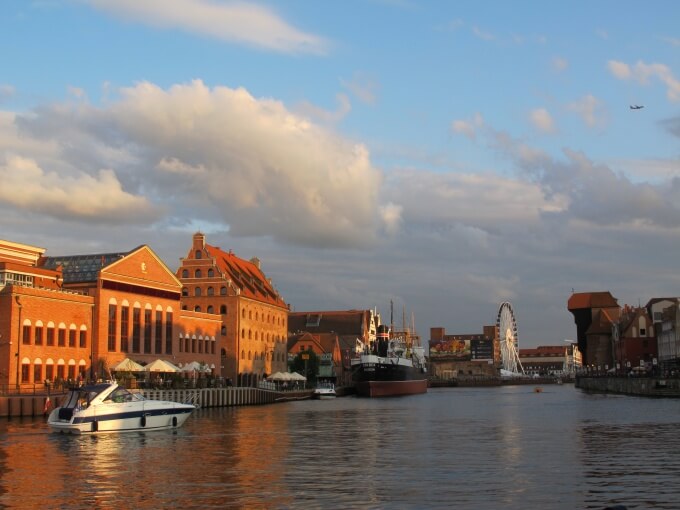
Gdansk is a mixture of very modern buildings, lovely old churches, buildings restored to 18th and 19th century splendor after the devastation of World War II, and enticing side streets and alleyways begging to be explored. These side streets are remarkable for very friendly hole-in-the wall restaurants, shops offering much better prices than those on the main boulevards, and unexpected hidden architectural gems at every other turn. The main boulevards in Gdansk are breathtakingly beautiful, faithfully rebuilt to medieval or Belle Époque glory when Gdansk was a thriving and very prosperous seaport and trade city, replete with money from the amber and silver trade.
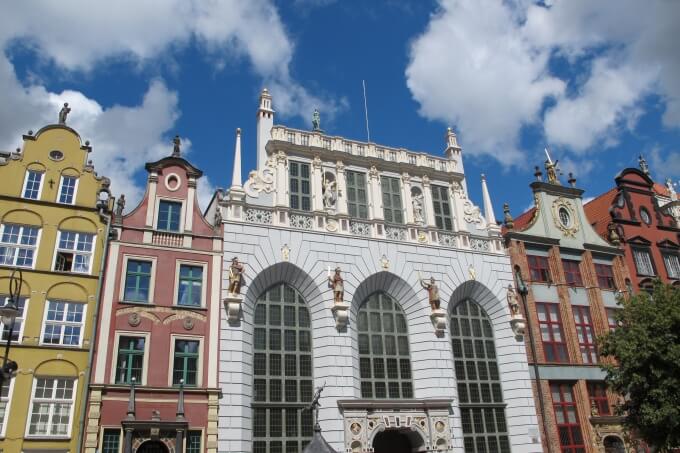
The proliferation of ugly communist era graffiti on the walls of the buildings along the one-cart-wide side streets of Gdansk (and Warsaw) is a heartbreaking reminder of Poland’s communist era. As we traveled through the western areas of Pomerania, we encountered rusted green WWII German army tanks prominently placed in the central squares of small towns and villages — another conspicuous reminder of Poland’s turbulent history.
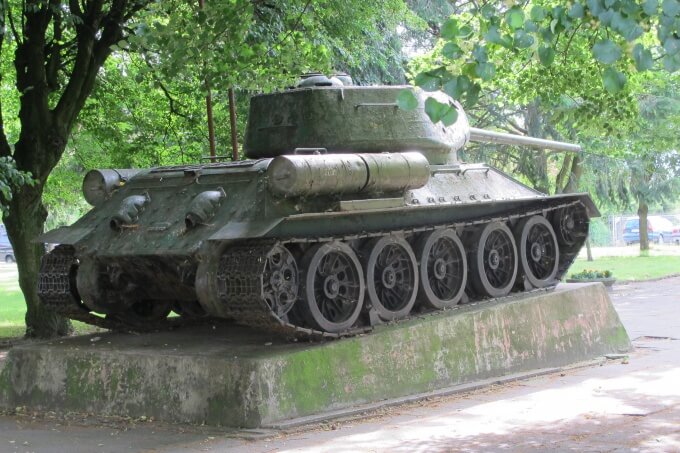
Two attractions not to be missed in Gdansk are the Amber Museum and an express train trip to the 15th century Malbork Castle. The Amber Museum details the fascinating history of how amber once made Gdansk and its environs one of the richest city-states in Europe. The museum astonishes the viewer with the pliancy of amber, a fossilized tree resin found in marine sediment. In pre-modern eras, amber simply washed onto Baltic beaches and was harvested as a gift from the sea. Malbork Castle, the largest Gothic fortress in Europe and headquarters of the marauding Teutonic Knights during the Middle Ages, was severely damaged during World War II and has, once again, been restored to red brick majesty. The Malbork train station, with its exquisitely painted folk motifs, heraldic details, and quixotic architecture, reminded Leslie of the production design for Disney’s “Frozen.”
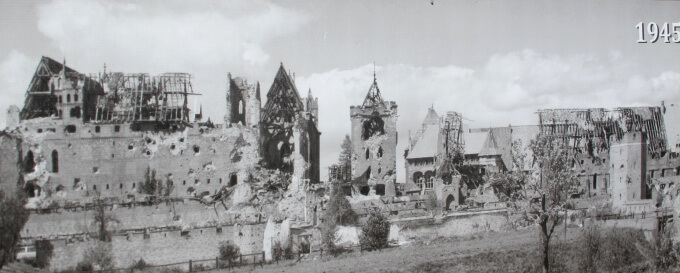
Our relatives feted us: Each tried to outdo the other in cordiality, food, drink, and displays of regional folklore. The social protocols as we entered each home were the giving of gifts, by both the guest and the host, and the exchange of three air-kisses on the cheek — left, right, and left again. As Leslie and I had been advised (in gestures) by the plump and rosy-cheeked owner of the only deli in my cousin’s village, the best gift for a guest to present to a host is a bottle of Smirnoff Vodka or a box of quality chocolates. Excellent advice.
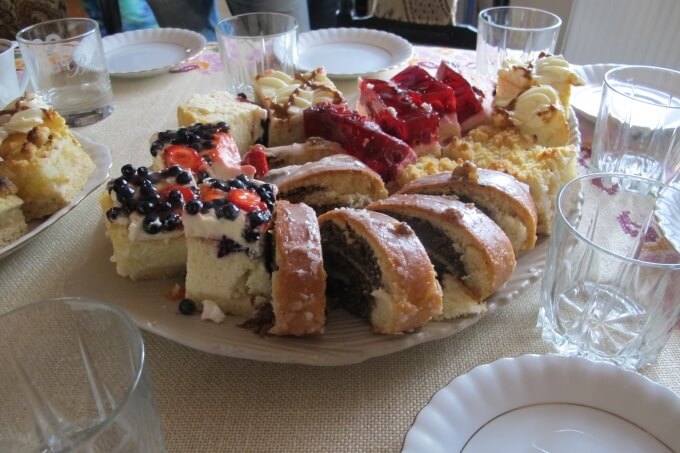
The drive to the wedding celebration was a 45-minute car trip further west of our cousin’s village along hilly highways bordered by dense forest. This far western section of Pomerania is architecturally very Germanic, an anachronism of the numerous eras when this borderland had been annexed by Germany. The celebration was a superb, formal dinner at Hotel Podwelis, a manor house reminiscent of the Captain’s house in the “Sound of Music.” The French doors of our opulently decorated dining room opened onto a magnificent lake view.
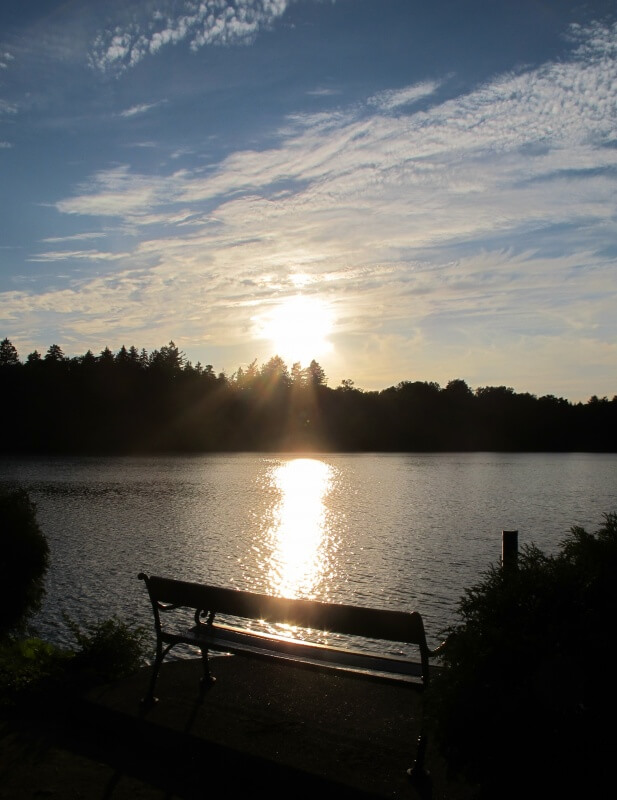
Pomerania is very humid because of the Baltic Sea. There is no air conditioning in typical Polish homes or in the village hotels. Leslie and I struggled with the dense humidity during the three days of the various wedding celebrations but nonetheless managed to match the joyful gusto of the other wedding guests.
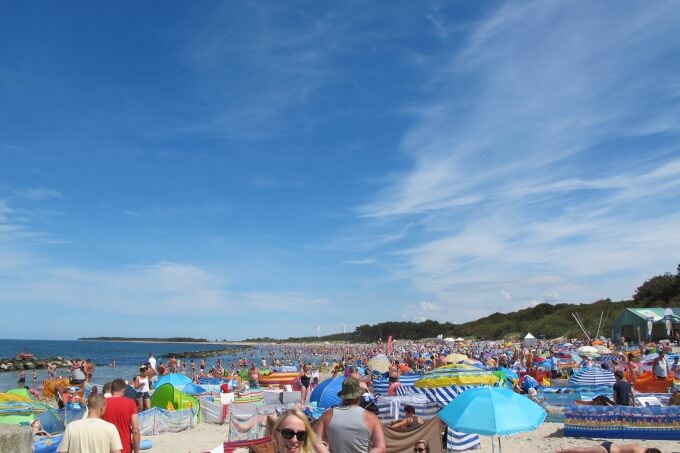
The most touching moment of the visit occurred when we walked through the graveyard where many of our relatives are buried. We were teary eyed when we found the grave of my grandmother. The astonishing thing is that graveyards in Poland feel like parks: Relatives come and go, buff the marble of the above ground sarcophagi, keep the votive candles lit, sit and pray, plant flowers, and refresh the bouquets. We were told it is typical for relatives to come to the graveyard once or twice a week.

After we said a fond goodbye to our relatives, Leslie and I boarded an intercity train to Sopot, a seaside resort north of Gdansk, and then a sleek Pendolino bullet train from Sopot to Warsaw. The Pendolino trains in Poland began operating in the fall of 2014 and they have significantly reduced travel time between the major cities. These trains are well appointed, very comfortable, and by U.S. standards, inexpensive. First or second-class tickets can be purchased for most intercity trains. Second class tickets are very inexpensive and the coaches are clean and comfortable.
Unfortunately, baggage room is limited in second class. Tourists and business people typically purchase first class tickets. Pendolino coaches are comparable to our newest Amtrak trains and entitle the ticket holder to the help of the conductor with baggage handling and storage.
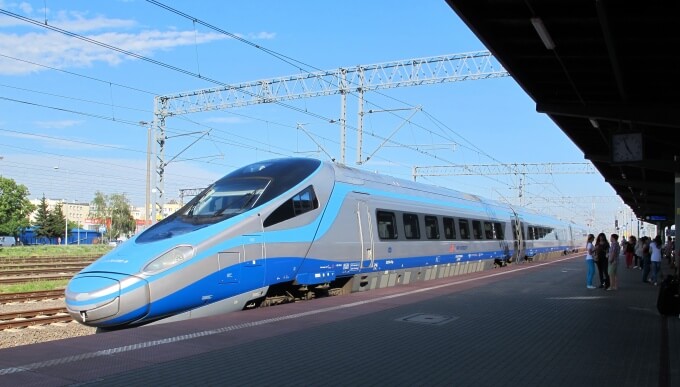
The train system in Poland is complex to navigate, forcing the tourist to cope with a dizzying array of acronyms (EIP/aka Pendolino, EIC, IC, TLK) representing the transit subdivisions within the Polrail system. The Pendolino trains are very popular and must be booked in advance using the Polrail website or a ticket agent. To understand Polrail’s transit subdivisions before booking online, this is the must-read webpage.
Ticketing problems can be resolved by standing in line at Polrail’s customer service offices inside the larger train stations. On-line booking errors are refunded only if the ticket printout can be shown to the customer service clerk. It is important to note that TLK trains connect only the smallest towns and villages. We did not use these trains, but from our observations, they seemed decades old. Ticket attendants at the large city stations understand English and are generally very helpful. We found that at small stations, a few Polish transportation-related words and phrases are essential.
A few key tips for Polrail bookings:
- You must create a login and password in order to buy tickets. Note that the Pendolino ticketing is separate from the other train subdivisions.
- The Google Maps option for connections between cities is very useful for a first look at ticketing possibilities.
- Purchases are made using credit cards and are posted in zlotys, the local currency, so be aware of the exchange rate being used by Polrail.
- Polrail uses 24 hour clock time and day-month-year notation, so be very careful to double check time and date.
- If the tickets selected are not available, the website will not tell you directly but will bump back to the selection webpage, so choose another ticket combination and try again.
- Return emails with your booked ticket/barcode can take up to 24 hours (or more) to arrive.
We arrived in the center of Warsaw on a gray, overcast Sunday afternoon to begin our very short visit. Warsaw is primarily a business hub and felt desolate during the weekend. Visually, the city is burdened with Soviet realist architecture, including buildings such as the Palace of Culture and Science, built as a “gift” for the people of Poland by Josef Stalin in the 1950’s. The Palace, a sprawling cement and stone behemoth topped by a curious pagoda-like structure, dominates the cityscape. At night, the Palace is lit with colors that change hue.
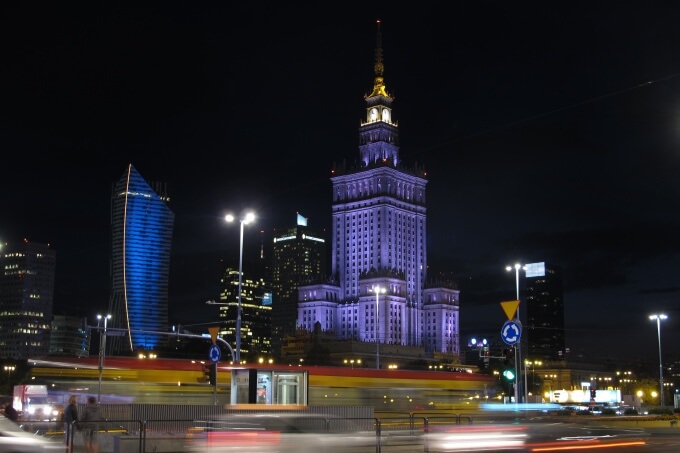
After consulting our online Michelin guidebook, we discovered lovely areas and panoramas a few long blocks walk from the center of the city. Many could be viewed from Nowy Swiat, the main promenade in the Old Town. Nowy Swiat was crowded with sightseers, and lined with charming shops, cafes, and restaurants bursting with tourists. The neoclassical buildings along this boulevard were brilliantly white and, in the evening, reflected the golden red light of the setting sun. As we strolled further along, we discovered the elegant Radziwill Palace, the so-called “Polish White House” and official residence of the President of Poland. Unfortunately, we could not squeeze any of the other intriguing attractions into our short time in this city.
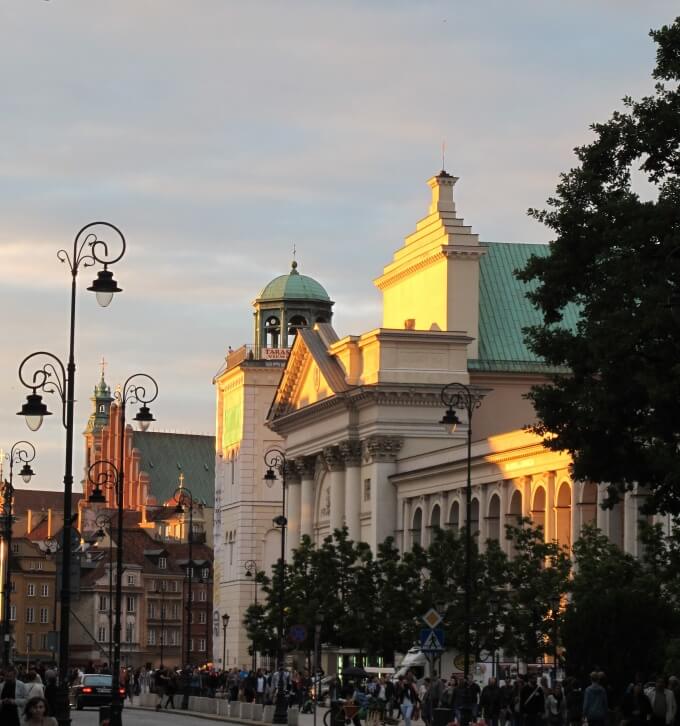
We rented a mid-size Toyota Auris in Warsaw and drove 75 miles east toward Bialystok and Russia to visit some friends who live in a tiny crossroads village. This area of Poland is a vista of endless acres of crops interspersed with herds of pretty (yes they were pretty!) dairy cows. Renting a car for one day was expensive, but well worth the experience. Cars use the same side of the road as we do in the U.S. Our rental had an automatic shift and handled beautifully. The road signs, of course, are in Polish, so we printed out a two-page dictionary of road sign pictographs to help us. With the in-car GPS and Leslie’s navigation using Google Maps, we were able to find our way through the tangle of city streets and into the heart of the Mazowsze region. The major highways in Poland are like our secondary roads, and some of the drivers are reckless, but we did not encounter anything a U.S. driver familiar with city driving could not handle.
From Warsaw, we took the Pendolino train to Krakow — a magical city and the capital of the Malopolska region. The Hotel Wawel, recommended by our experienced advisor, was fantastic, decorated in lavish Belle Époque décor.
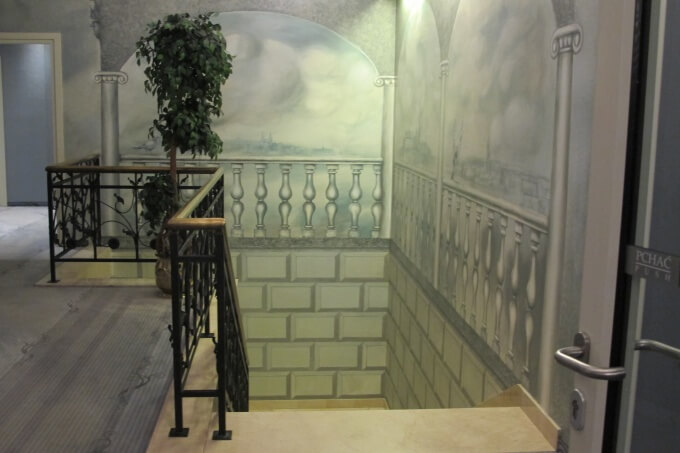
This hotel is a few blocks north of the stone fortress perimeter of Wawel Castle, one block from the superb central square in the center of the Old City, and next to a cloistered convent. The convent is so close that we could hear the nuns chanting and singing at mass and vespers in the morning and evening. The enclosed atrium garden at the back of the hotel sparkled with mini-lights and beckoned guests and diners from the hotel’s restaurant to linger with their after-dinner brandy. A generous breakfast buffet was included with our booking. The wait staff made sure a hot plate of eggs was prepared when we caught the last breakfast seating. We chuckled when we saw Krakowska (a regional kielbasa) served as breakfast sausage. Cheese, cold cuts, and salad are considered breakfast fare, as are yogurt and fruit salad. The concierge at the hotel was obliging, helping us with directions, general information, and transport issues. We wanted to take the trams to reach the outskirts of town, and the concierge quickly gave us, in English, instructions on how to operate the ticket kiosks.
The weather was just perfect, and we crisscrossed the cobbled main boulevards and side streets, walking miles without feeling fatigued. The central square is lined with shops and restaurants, and the main castles, churches, and tourist attractions are within walking distance. Leslie felt Krakow reminded her of the summer she spent at Oxford, and I loved the bustle of the tourists, the medieval beauty of the buildings, and the fantastic restaurants and food. We could not believe the variety of the cuisines available — Georgian, Indian, Thai, Chinese, as well as kabobs and traditional soft poppy seed pretzels (obwarzanki) hawked by street vendors. Regardless of the restaurant’s dominant cuisine, at the back of the menu, popular regional Polish dishes such as kotlet schabowy (crispy chicken or pork cutlets) and bigos (mixed meat stew) were usually available.

The sightseeing possibilities in Krakow made our heads spin, but the must-see destinations include Wawel Castle and Wawel Cathedral, Collegium Maius at Jagiellonian University, and St. Mary’s Church. The best way to tour Wawel Castle is with an English-speaking guide — the castle is an enormous labyrinth and a guide is essential. Tours of Wawel must be arranged ahead of time, via either website or phone. An unexpected bonus at Wawel Castle was our ability to view Leonardo Da Vinci’s allegorical masterpiece “Lady with Ermine,” on temporary exhibition from Krakow’s Czartoryski Museum. Art buffs will be mesmerized. History buffs will be stunned by the description of the painting’s losses and re-discoveries over the centuries!
Krakow is at heart a university town, and the Collegium Maius presented us with ten centuries of intellectual history and artifacts. Again, an English-speaking tour guide is essential to enjoying the delights of this medieval compound, from the elaborate woodcarvings in the dining room of the professorial monks, reminiscent of the dining halls portrayed in the Harry Potter movies, to the Arabian astrolabe from 1054 that inspired the heliocentric theories of Copernicus.
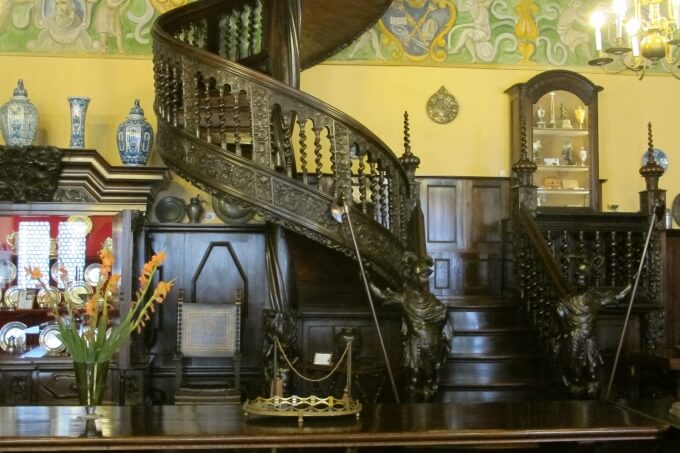
St. Mary’s Church has the most majestic interior of all the extraordinarily beautiful churches we saw in Gdansk and Krakow — the azure blue vaulted ceiling studded with golden stars over the main altar simply stunned us.
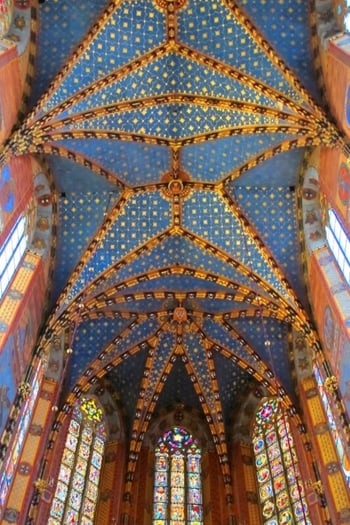 The concierge at the Hotel Wawel quickly arranged the half hour taxi ride from the Old City to John Paul II Airport, and we wistfully watched exquisite Krakow grow more distant through the windows of the comfortable Mercedes. The taxi driver was debonair, spoke English very well, and chatted with us gaily as he drove, providing a bit more background to our recitation of the wonders of Krakow.
The concierge at the Hotel Wawel quickly arranged the half hour taxi ride from the Old City to John Paul II Airport, and we wistfully watched exquisite Krakow grow more distant through the windows of the comfortable Mercedes. The taxi driver was debonair, spoke English very well, and chatted with us gaily as he drove, providing a bit more background to our recitation of the wonders of Krakow.
As he shook our hands good bye, he used the Polish salutation of dowidzenia — good-bye until we see you again. We replied bardzo byli przyjemnie — we enjoyed ourselves very much! Till next time…
Click here to start booking your very own adventure!
Photos by Leslie Hart

About the author
TRAVELINK
TRAVELINK is headquartered in Nashville, Tennessee and operates nationally with a combination of boutique business call centers and a national network of experienced virtual business travel and leisure travel advisors. Travelink’s client base includes a range of Fortune 500 Corporations, small to mid-market companies, as well as clients from the entertainment industry, sports teams, groups, and religious & non-profit organizations.
Topics: Hotels + Resorts, Europe, Family, Food + Culture